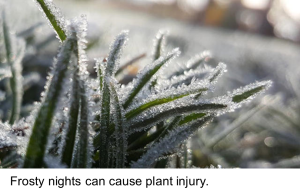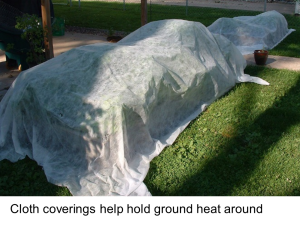
Shannon Kennedy, ANR Educator, UGA Extension Forsyth County
Oh, how wonderful the cool weather is! The brisk mornings roll into perfect afternoons, fire pits are crackling and marshmallows, chocolate bars, and graham crackers are flying off the shelf. Unfortunately, with the onset of this blissful sweater weather, there comes the threat of frost damage to our landscape.
This time of year, perennial plants prepare for dormancy; they stop producing new leaves and they store energy in their wood and roots. If the plants have not completed this process before temperatures reach 32 degrees Fahrenheit, the water in the plant cells freezes, expands, and ruptures the cell walls. This is what causes the characteristic mushy, drooping injury in plants. Cold or windy conditions can also cause leaf browning and scorch, twig death, and in extreme cases bark-splitting. Usually it is obvious that your plants sustained cold damage, but occasionally the effects of a freeze show up weeks or months after the weather that caused the injury.
So, what can you do to protect your plants from such a sad fate? As with most gardening issues there are preventative measures… and more preventative measures. The best way to avoid frost damage is to plant species that are hardy in USDA Zone 7. Also, be aware of the areas within your landscape that are less sheltered. Plants placed in full sun are out in the open to provide their required light, but on clear cold nights, radiational freezes will threaten these sun-loving plants. Windy areas are also more exposed and thus more likely to cause damage. Lastly, know that your lovely container plants cool down faster than other plants because they are separated from the ground. No matter how large your flowerpot is, it will not insulate the plants’ roots the same way that the ground will, so it would be best to move them inside before a freeze injures or kills them. But what if it’s too late? You planted the wrong thing in the wrong place, and you’re desperate to save it before the first frost takes it out. The best thing you can do for a tender plant is to dig it up and to put it in a planter to store inside during winter. If that isn’t an option, this is what you need to do: maintain proper soil moisture, avoid nitrogen fertilizers, and mulch your plants as temperatures cool off. It may seem counterintuitive to water a plant to avoid freezing injury, but a drought-stressed plant will be weakened and thus more susceptible to other types of damage. Nitrogen fertilizers encourage the plant to produce new leaves – the exact opposite of what it should be doing in fall – so avoid using nitrogen fertilizers while plants enter into and maintain dormancy. Lastly, at night the ground radiates the heat it has collected during the day, so mulch will trap heat from the ground. It also retains moisture.

When the forecast predicts a freeze, cover your plants with cloth or cardboard. You want the material to span the space above the plant and make contact with the ground around the plant; this will help pool rising heat from the ground around the plant. It is also a common practice to create a frame or use a large cardboard box to support the weight of the covering fabric so that it doesn’t damage branches. Plastic will work to cover plants and keep the heat in, but you will need to remove the plastic shortly after daybreak. The reason for this is that plastic will heat quickly in sunlight, and while you intend to protect your plants from the cold, you could end up baking them instead.
Historically our first frost tends to happen at the end of October or beginning of November, so keep an eye on the forecast in the upcoming weeks. If you have any questions, feel free to contact the Extension Office at forsyth.extension@uga.edu.